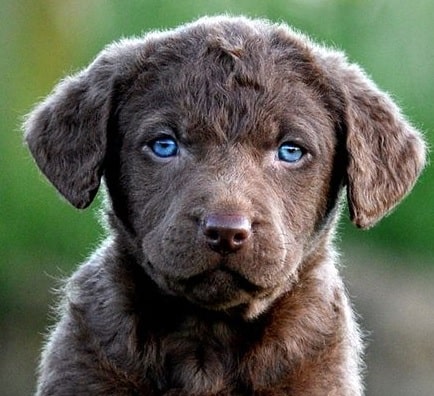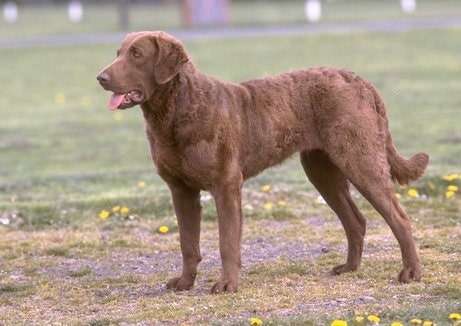Chesapeake Bay Retriever Puppies
The Chesapeake Bay Retriever is a large-size breed that originated in the United States as market hunting, retrieving, and rescuing. These breeds are playful, affectionate, and tireless companions also known for their love for water and ability to hunt. Its size can vary from medium to large size which is more like Golden Retriever. A Chesapeake can give birth to 4-6 puppies at a time.
In this article, you will learn about Chessie’s behavior and different development stage from newborn to adult phase. Additionally, you will get to know about vaccination for different diseases, so stay tuned for it.
Newborn
The newly born Chesapeake baby is completely blind, deaf, toothless, and are unable to walk. It is very sensitive time period for the puppy as they are entirely dependent on their mother. They shouldn’t be fed anything solid as their teeth aren’t grown yet. Likewise, the puppies can’t generate heat on their own so, the needed warmth is provided by their mother. Due to lack of heat in the pup’s body, it can die from hypothermia.
The eyes of the newborn are sealed and will naturally open after 10-14 days so, don’t try to open their eyes. Mother’s milk should only be fed to the pup rather than processed food as it keeps them safe from other harmful infections and diseases.
Neonatal Stage (0-2 Weeks)
During the neonatal stage, Chessies fully rely on their mother as they can’t see or hear anything. They only have a good sense of smell which helps them to get closer to their mother. The pup slowly crawls towards the mother using feet which help in the development of their muscle and strengthen bones. During the first two weeks from its birth, they need 90 percent of sleep throughout the day. These two weeks are only for eating and sleeping as they also help in the proper development of body and mind.

Image Source: Pinterest
The mother keeps the baby warm for the time period and licks their belly to help them defecate. After 10-14 days, they start to open their eyes, however, their vision will still be blurry. At the end of the two weeks, Chessie starts gaining double its birth weight.
Transitional Stage (2-4 Weeks)
Now Chessie goes through the neonatal to the transitional stage where they are able to see and hear things properly at the end of the second week. They also try to get on their feet and walk with their wobbly move. The pup will form their own way of communication with their littermates by yelping, whining, and barking. In addition, they will be stronger and playful also will interact with their playmates and mother.
The puppy is now grown enough to regulate its own body temperature. As for now, the mother teaches them to behave and socialize with each other. They also learn to poop and pee outside their nest as the mother stops cleaning for them. Slowly, the mother gets away from her children giving herself more time to rest.
Socialization Stage (4-12 weeks) Changes
The socialization session is very important for the puppy as it’s time for their socialization and training. You must be careful at this time as their behavior stays with them forever. This is the perfect time for you to start teaching your pup as their developed mind can learn some commands and tricks taught to them. So, it’s best to start training Chessies at an early age.

Image Source: Adobe Stock
At the starting time of the fifth week, your pup can become noisy as it has properly learned to bark properly. Moreover, they also gain weight of 9 to 10 kg per week. Throughout the eight-week period, you can also teach them some basic command or obedience training. Make sure you socialize your Chessie properly as they can grow into an aggressive dog and can be fearful of other humans and dogs if not socialized properly.
Juvenile Stage (3-6 months)
When Chessie enters the Juvenile stage, they start to lose their puppy face while getting their adult face. Their puppy face also starts to fall out while growing a new full set of teeth. Remember during the new teeth period, your pup will chew stuff around him so hide valuable stuff for the time being. As your Chessie is growing, he needs more food for his development so, feed him 3 times a day. But don’t overfeed him as it can lead to obesity which is bad for his overall health.
As they enter adulthood, you can begin their advanced training, sporting training, and teach new tricks and commands. At this age, your Chessie becomes more confident and grows stronger. The pup might also show some dominating and stubborn behavior which must be corrected immediately.
Adolescent Stage (6-12 months)
Chessie enters into puberty at the age of 6 to 1 year where his adolescence period starts as well. By this time, your pup has been grown into a fine adult dog with a full-grown face and body. As for the female Chesapeake, they experience their first heat meanwhile, the male shows more interest in females at the time. However, breeding them at the moment is not appropriate as their body and mind aren’t fully developed for it. If the breeding is done, it might affect their health.

Image Source: Pet Keen
Vaccination Chart for Chesapeake Bay Retriever
| 6 to 8 Weeks | Distemper, parvovirus |
| 10 to 12 Weeks | DHPP (vaccines for distemper, adenovirus, parainfluenza, and parvovirus) |
| 16 to 18 Weeks | DHPP, rabies |
| Every 1 to 2 Years | DHPP |
| Every 1 to 3 Years | Rabies (as required by law) |
Vaccination Chart For Chesapeake Bay Retriever.
Vaccination cost for Chesapeake Bay Retriever
The cost of vaccination for your Chesapeake Bay Retriever is between $74-$100 for 6 weeks-16 weeks. The cost for rabies vaccine cost between $15-$20.
Visit Doglime for more dog breeds information and their puppies behavior.
Tags










